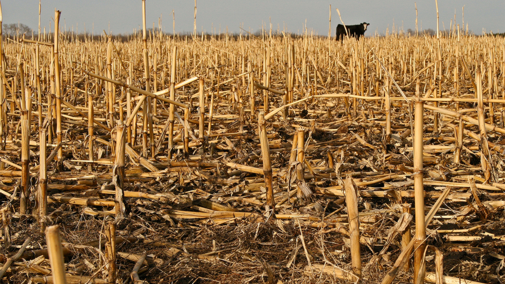Grain Sorghum Stover/Stalks Grazing
Grain sorghum stover compares favorably to cornstalks as a forage resource. Both corn residue and sorghum stover can be good nutrition for mid- to late gestation cattle following fall grain harvest. Sorghum leaves have similar quality to corn husk and leaves; however, the quality decreases over time.
Although both crop residues provide the highest nutrient content when grazed soon after grain harvest, it is highly recommended to prioritize grazing cornstalk fields first. Corn leaves tend to detach from stalks within one to two months after harvest and blow out of fields; thus, dramatically lowering the grazing nutrition. In contrast, grain sorghum stover leaves remain attached to their stalks much longer into the winter and early spring. Previous grain sorghum yields can be used to set optimum grazing stalking rates. For example, grazing rates might be 1 acre per cow per month for every 100 bushels of grain sorghum harvested this fall.
Unlike corn residue, grain sorghum stover has a threat of prussic acid toxicity immediately following a frost. Due to our warmer fall temperatures, many alfalfa fields and light perennials like sorghum are still green. Therefore, delay grazing turnout until seven days, after plant killing freezing temperatures, to reduce prussic acid toxicity risk. Also, sorghum stover’s higher nutrient stem content may make it more prone to nitrate toxicity risk — limit grazing of drought-stressed residue fields so cattle are not forced to graze lower stalk stems. On the upside, spilled sorghum grain is safer than corn grain and not as likely to cause acidosis or founder.
More crop residues research information is available on CropWatch and UNL Beef.
Winter Grazing
Grazing stockpiled winter range or pastures has several benefits. It is much less costly compared to feeding hay. On native range, there is little risk of damage to the grasses because they are dormant and winter stocking rates can be somewhat higher compared to the summer. Often times, you will notice that native pastures only grazed during the winter are the most vigorous and productive.
It is important though, that you closely monitor body condition of the cows during the winter grazing period. Crude protein is generally the most limiting nutrient during winter grazing. The crude protein content of dormant warm-season grasses will be around 5 to 7% and will slowly decline through the winter months from weathering and as the cattle selectively grazing the higher quality forage in a pasture.
Stockpiled cool-season grass pastures are those that have been only lightly or not grazed during the growing season. These pastures may have slightly higher crude protein levels, but that quality will also decline as the winter progresses. Feeding the right amount of protein supplement while winter grazing will allow the cows to effectively utilize that winter forage and maintain the desired body condition.
A possible grazing management strategy that can be used is to do simple rotational grazing where cattle are periodically moved to a new winter pasture. This will allow for a more consistent diet quality when winter grazing.
Whatever your strategy, though, consider carefully what kind of nutrition animals are getting from the pasture so you neither underfeed nor overfeed expensive supplements. And be sure to provide salt, calcium, phosphorus, and vitamin A free choice at all times.
Winter grazing is a great opportunity to reduce winter feed costs. With proper management, it can help you meet many of your feeding goals.

